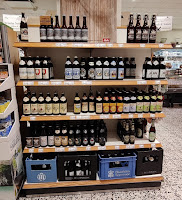As my friend Paul recently reminded me via his blog, the North German mediaeval Hanseatic town of Lüneburg – where I used to live – remains a popular tourist destination for cruise passengers, coach parties and more. I’m a bit too late to help Paul, but if you’re visiting in the near future and are interested in beer, here’s a few ideas of places to look.
There’s only two commercial breweries in town these days, both brewpubs. Brauhaus Nolte is quite a way out from the centre, so it’s unlikely a casual visitor will make it there – although if you do, it’s very much a local pub, with a traditional menu (think schnitzels, etc) and usually one light (Helles) and one dark (Dunkel) beer, plus maybe a seasonal special. This range is typical for a German brewpub.
 |
| The bar at Mälzer |
As usual, two regulars plus maybe a third seasonal, though the tweak here is that the second regular also changes – a Marzen from October, and a Weizen from April. The first is a Pilsner, of course. It’s not cheap – well, we are in tourist-town here – but it’s a nice place to sit and eat, or just drink, there’s even free WiFi now. Beware though that, like a lot of German places, they don’t take Visa or MC, only cash or a German bank card.
 |
| The 1902 brewhouse |
It’s several years since I visited the museum, but the brewhouse (which dates from 1902) was a very interesting image of early 1900s and inter-war German brewing. It looks like it’s a lot more accessible now too, having been connected to the adjacent Ostpreußisches Landesmuseum* – when I visited, it was pre-booked groups only, and the guide had to open it up specially with a large key… Well worth a look if you have time.
A five-minute walk from here will bring you to the Altstadt – the old town. Here you can stroll along Ob. & u. Ohlingerstraße (Upper and Lower Ohlinger Street) for the lovely old buildings, but from the beer perspective what I recommend is Anno 1900. It's nominally a traditional German restaurant – their motto is “eat like in your grandmother’s time”, and yes they mean the mythic past, not your actual grandmother’s time which whether British or German probably involved post-war rationing. The downstairs though is a nice pub full of wood, ‘found items’ and memorabilia, and complete with a Stammtisch – a table set aside only for locals.
 |
| Anno 1900 |
None of which are local, of course, and you’ll have a hard time finding much that is – unless you count maybe Ratsherrn and the various Holsten/Carlsberg brands, which are from Hamburg. There are a few more brewpubs and nanobreweries in outlying villages, but with only limited distribution.
And while most larger supermarkets keep a range of national brands plus some Bavarians, sadly the pandemic and other factors have hammered the availability of modern German microbrewed beer. The town’s only specialist beer shop closed a few years back, and others have drastically cut back. For instance, I used to recommend Avenir café-deli for speciality brews, but now it has little beyond a few bottles from Kehrwieder Kreativbrauerei – although that said, these are well worth trying, and the coffee is still good! (They sometimes have Wildwuchs beers too, but in my experience these vary a lot in quality, as do those of local brand LüneBräu which you might find in other shops.)
 |
| Franconia in Sand Passage |
Well, that’s about it. To be honest, if you have time and transport then the beer range is far better in Hamburg, which has several specialist shops. But you can still find something good to drink in Lüneburg, even if it’s not brewed especially locally.
Thanks for the link to my blog, Bryan. As I said in the post, I would liked to have spent some more time in Lüneburg, but the cruise excursions run to a very tight schedule. The tour guide did mention Lüneburger Kronenbrauerei and was correct in thinking that the brewery had been brought by Holsten.
ReplyDeleteI did wonder about the East Prussian State Museum, but following the annexation of that part of Germany, by Poland and Russia, at the end of World War II, I understand the reason for its presence in Lüneburg. The Soviets carried out some rather brutal ethnic cleansing in East Prussia, which was an area where Germans had lived for centuries.
Their determination to erase several hundred years of history, extended to destroying churches and bull-dozing the gravestones. A friend of mine had a father-in-law who came from East Prussia. He was a POW in England during the war, and was unable to return to his homeland afterwards, because of what had occurred there. He stayed here instead and ended up marrying my friend’s wife’s mother.
The story of the millions of ethnic Germans displaced after the war is not as well known as it could be - as well as East Prussia and the Sudetenland, they came from all over - including descendants of those encouraged by Catherine the Great to settle near the Black Sea. Absorbing those refugees was a major effort for the new Bundesrepublik, and may have contributed to its generally welcoming (or at least more welcoming than others) attitude to modern-day refugees. It's a topic that is getting more attention now - I saw the new exhibition on it last year at Kiekeberg Freilichtmuseum: https://www.kiekeberg-museum.de/blick-ins-museum/koenigsberger-strasse/projekt/
DeleteThis comment has been removed by the author.
ReplyDelete